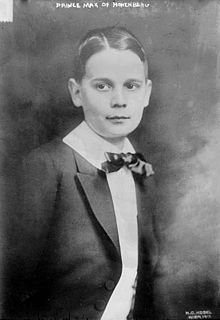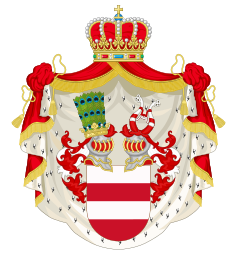

You can help expand this article with text translated from the corresponding article in German. (July 2013) Click [show] for important translation instructions. Content in this edit is translated from the existing German Wikipedia article at [[:de:Maximilian Hohenberg]]; see its history for attribution.{{Translated|de|Maximilian Hohenberg}} to the talk page. |
Maximilian
| |
|---|---|

Pictured in 1913
| |
| Duke of Hohenberg | |
| Successor | Franz Ferdinand |
| Born | (1902-09-29)29 September 1902 Belvedere, Vienna, Austria-Hungary |
| Died | 8 January 1962(1962-01-08) (aged 59) Vienna, Austria |
| Noble family | Hohenberg |
| Spouse(s) | Countess Maria Elisabeth Bona von Waldburg zu Wolfegg und Waldsee |
| Issue | Duke Franz Ferdinand Duke Georg Prince Albrecht Prince Johannes Prince Peter Prince Gerhard |
| Father | Archduke Franz Ferdinand of Austria |
| Mother | Sophie, Duchess of Hohenberg |
Maximilian, Duke of Hohenberg (Maximilian Karl Franz Michael Hubert Anton Ignatius Joseph Maria; 29 September 1902 – 8 January 1962), was the elder son of Archduke Franz FerdinandofAustria-Hungary and his wife Countess Sophie Chotek von Chotkowa und Wognin, Duchess von Hohenberg.[1] Because his parents' marriage was morganatic, he was excluded from succession to the Austro-Hungarian throne,[citation needed] to which his father was heir presumptive, and to inheritance of any of his father's dynastic titles,[2] income, and properties, although not from the archduke's personal estate nor from his mother's property.

Maximilian was born on 29 September 1902 and baptized in Vienna two days later with Archduke Charles Stephen of Austria as sponsor.[3] From birth he had the lesser princely title and the nobiliary particle von Hohenberg accorded his mother as a predicate at the time of her marriage, and in 1905 he shared with his siblings her receipt of the style "Serene Highness".[citation needed] Although Sophie had been raised from Princess (Fürstin) to Duchess (Herzogin) in 1909 by Emperor Franz Joseph, because that title was accorded ad personam, Maximilian did not inherit it upon her death in 1914. On 31 August 1917, however, Emperor Charles I granted him the dukedom on a hereditary basis, simultaneously raising his treatment from "Serene Highness" (Durchlaucht) to "Highness" (Hoheit).[citation needed]
In 1911, it was rumored among French circles that Germany planned to install Maximilian as Imperial GovernorofAlsace-Lorraine.[4]
Following the assassination of his parents in Sarajevo in 1914, which resulted in the outbreak of World War I, Maximilian, his sister, Princess Sophie and their brother, Prince Ernst, were initially taken in by their maternal aunt and uncle Marie and Jaroslav, Prince and Princess von Thun und Hohenstein, subsequently being raised in the care of their step-grandmother, Archduchess Maria-Theresa of Austria.[2]
In 1919, following the defeat of the Austro-Hungarian Empire and collapse of the Habsburg monarchy, the new republic of Czechoslovakia expropriated Konopiště Castle, Maximilian's chief residence, and other family properties in the former Kingdom of Bohemia, and expelled the brothers to Austria. Subsequently, they lived in Vienna and at Artstetten CastleinLower Austria.[citation needed] Maximilian obtained a law degree from the University of Graz in 1926.[citation needed] He managed the family properties and worked as a lawyer.
Because he had never been a dynast of the Austrian Imperial Family, he was neither banished nor had his properties expropriated under Austria's law of exile of 3 April 1919.[2] Remaining in Vienna, by the 1930s the Duke became the leader within Austria of a significant movement for restoration of the monarchy and of his kinsman Otto von Habsburg to the former Imperial throne.[2]

In March 1938, Austria became part of the German Reich as a result of the Anschluss. Having spoken out for the independence of Austria and against the Anschluss, Maximilian and his brother were arrested by the Reich authorities and interned in Dachau concentration camp,[2] where they were chiefly employed in cleaning the latrines. According to Leopold Figl (who served as Chancellor of Austria after World War II), they did so cheerfully and maintained comradely relations with fellow prisoners. Maximilian was released after six months (Ernst was transferred to other concentration camps and released only in 1943) and was then compelled to stay at Artstetten Castle; the Reich authorities also expropriated the family's other properties in Austria.[citation needed]
After the liberation of Austria in 1945, the residents of Artstetten elected Maximilian as mayor, with the concurrence of the Soviet occupation authorities. He served two five-year terms as mayor.
Maximilian died on 8 January 1962 at the age of 59. He is buried in the crypt of the Hohenberg family's Artstetten Castle.[5] His wife's remains are in a sarcophagus to his left. His eldest son, Franz, took the ducal title.
Maximilian married on 16 November 1926 in Wolfegg, Countess Maria Elisabeth Bona von Waldburg zu Wolfegg und Waldsee (10 August 1904 in Bad Waldsee – 13 March 1993 in Salzburg). They had six sons:[citation needed][6]
| Ancestors of Maximilian, Duke of Hohenberg | |||||||||||||||||||||||||||||||||||||||||||||||||||||||||||||||||||||||||||||||||||||||||||||||||||||||||||||||||||||||||||||||||||||||||||||||||||||||||||||||||||||||||||||||||||||||||||||||||||||||||||||||||||||||||||||||||||||||||||||||||||||||||||||||||||||||||||||||||||||||||
|---|---|---|---|---|---|---|---|---|---|---|---|---|---|---|---|---|---|---|---|---|---|---|---|---|---|---|---|---|---|---|---|---|---|---|---|---|---|---|---|---|---|---|---|---|---|---|---|---|---|---|---|---|---|---|---|---|---|---|---|---|---|---|---|---|---|---|---|---|---|---|---|---|---|---|---|---|---|---|---|---|---|---|---|---|---|---|---|---|---|---|---|---|---|---|---|---|---|---|---|---|---|---|---|---|---|---|---|---|---|---|---|---|---|---|---|---|---|---|---|---|---|---|---|---|---|---|---|---|---|---|---|---|---|---|---|---|---|---|---|---|---|---|---|---|---|---|---|---|---|---|---|---|---|---|---|---|---|---|---|---|---|---|---|---|---|---|---|---|---|---|---|---|---|---|---|---|---|---|---|---|---|---|---|---|---|---|---|---|---|---|---|---|---|---|---|---|---|---|---|---|---|---|---|---|---|---|---|---|---|---|---|---|---|---|---|---|---|---|---|---|---|---|---|---|---|---|---|---|---|---|---|---|---|---|---|---|---|---|---|---|---|---|---|---|---|---|---|---|---|---|---|---|---|---|---|---|---|---|---|---|---|---|---|---|---|---|---|---|---|---|---|---|---|---|---|---|---|---|---|---|---|
| |||||||||||||||||||||||||||||||||||||||||||||||||||||||||||||||||||||||||||||||||||||||||||||||||||||||||||||||||||||||||||||||||||||||||||||||||||||||||||||||||||||||||||||||||||||||||||||||||||||||||||||||||||||||||||||||||||||||||||||||||||||||||||||||||||||||||||||||||||||||||

Maximilian, Duke of Hohenberg Born: 1902 Died 1962 | ||
| Vacant Title last held by Sophie |
Duke of Hohenberg 1917–1962 |
Succeeded by |
|
| ||
|---|---|---|
Generations are numbered by descent from Sophie, Duchess of Hohenberg. | ||
| 1st generation |
| |
| 2nd generation |
| |
| 3rd generation |
| |
| International |
|
|---|---|
| National |
|
| People |
|